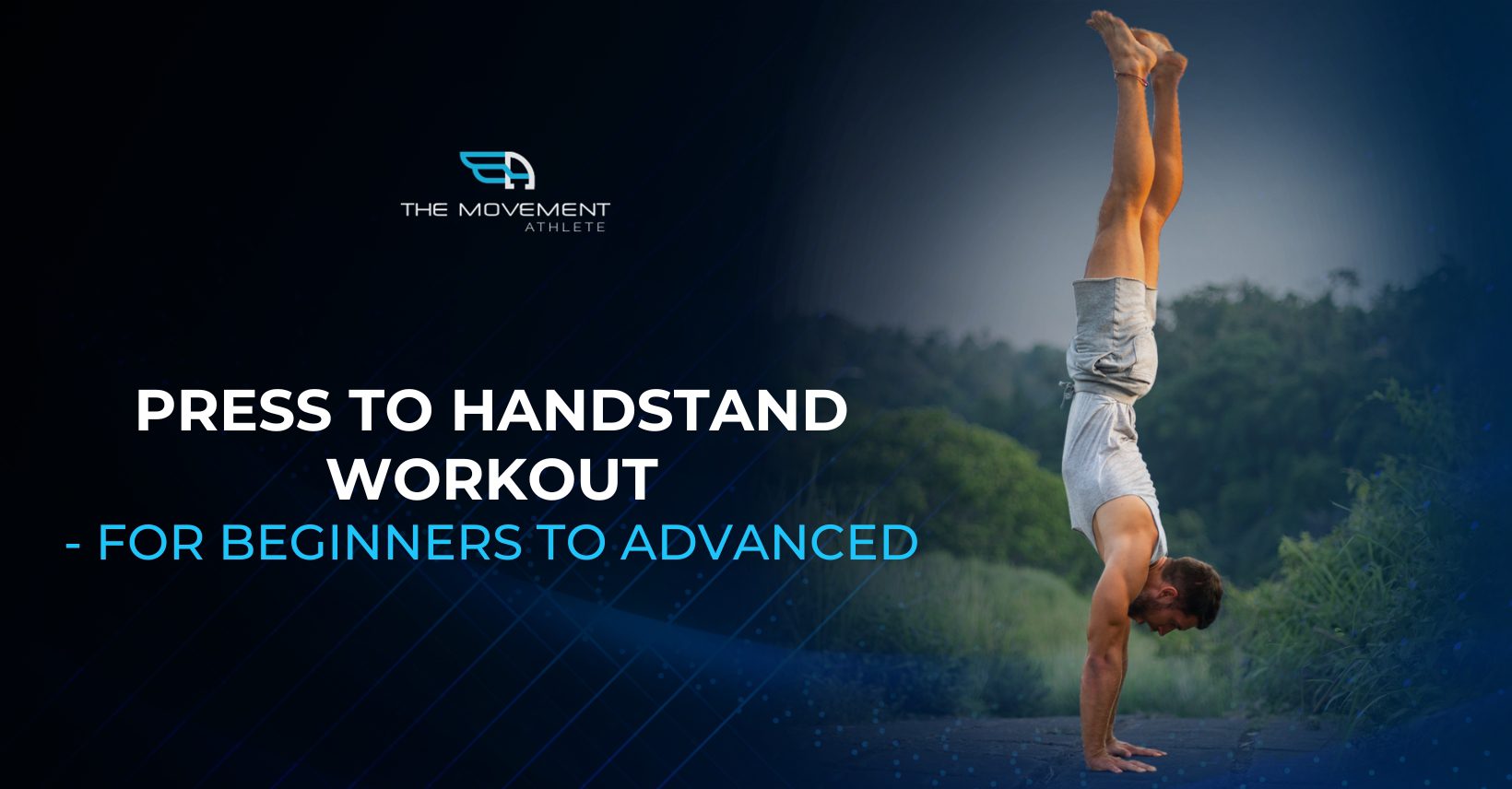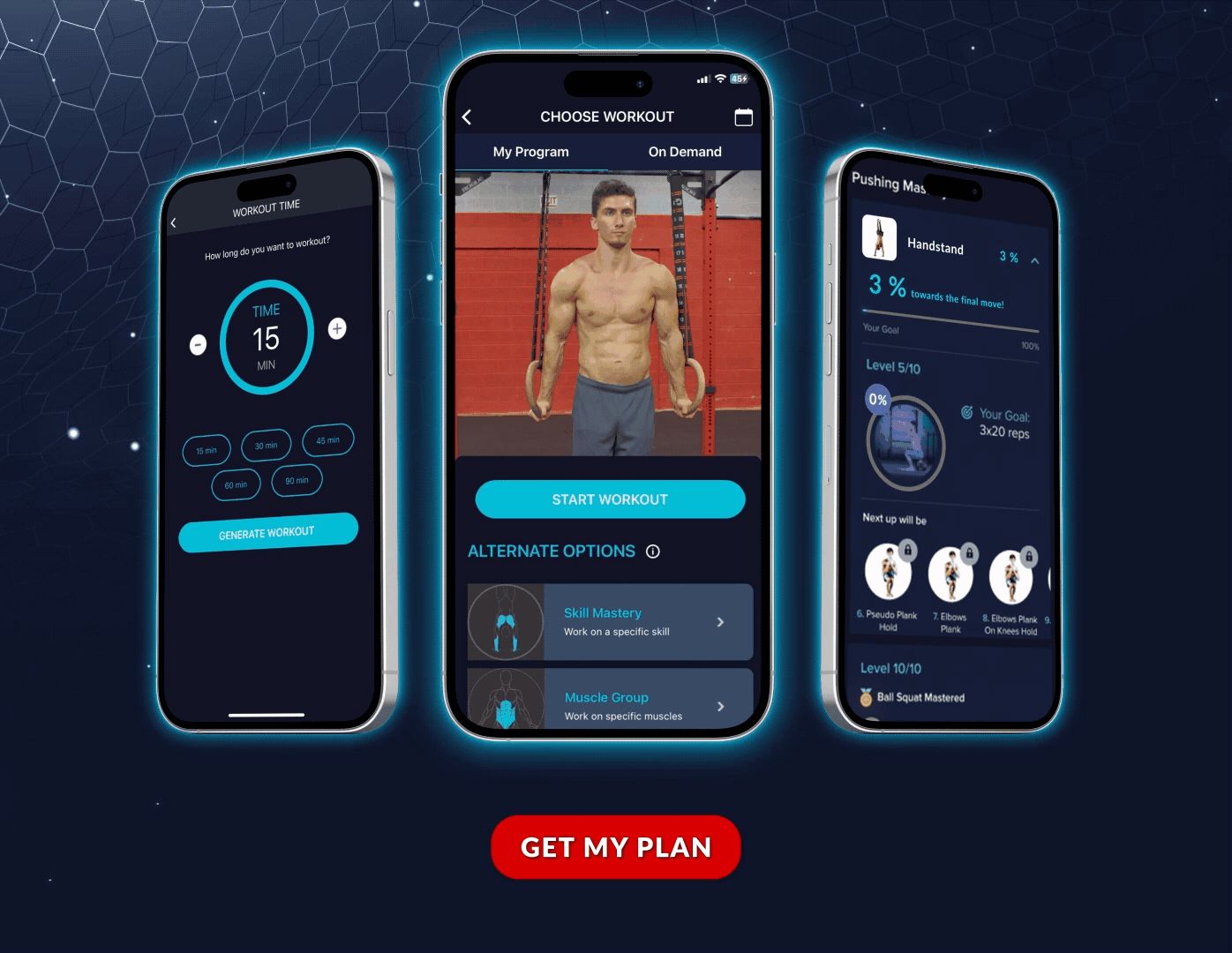

📖 Read Time: 15 Minutes
🏆 Join the Tribe!
Join the tribe of Movement & Calisthenics Athletes – people just like you that are working with their own body weight to get strength, lose fat build muscle, recover from injuries and live their best lives!
Take our FREE Movement Assessment →
💪Ready to take your handstand skills to the next level? This press to handstand workout combines skill development, strength building, muscle endurance, and cardiovascular conditioning all in one comprehensive training session.
This workout is designed to help you build the specific strength, mobility, and control needed for press to handstand progressions. Whether you’re a beginner working on your first press or an advanced athlete refining your technique, this session has something for everyone.
In This Article:
• Cooldown
🗓️ Training Schedule
This press to handstand workout should be performed 2-3 times per week with at least one rest day between sessions. This allows for proper recovery while maintaining consistent progress.
📅 Recommended Schedule:
• Monday: Press to Handstand Workout
• Tuesday: Rest or light mobility work
• Wednesday: Press to Handstand Workout
• Thursday: Rest or other training
• Friday: Press to Handstand Workout
• Weekend: Rest or recreational activities
🔥 General Warm-up (5-8 minutes)
Start your session with this general warm-up to prepare your body for the more specific movements ahead. This will increase your heart rate, warm up your joints, and activate the major muscle groups.
🏃 Cardio Activation
• Jumping Jacks: 30 seconds
• High Knees: 30 seconds
• Arm Circles: 15 forward, 15 backward each arm
🤸 Joint Mobility
• Shoulder Rolls: 10 forward, 10 backward
• Hip Circles: 10 each direction
• Leg Swings: 10 forward/back each leg
• Wrist Circles: 10 each direction
🎯 Specific Warm-up (8-10 minutes)
Now we’ll focus on movements that specifically prepare your body for press to handstand training. These exercises target the exact muscle groups and movement patterns you’ll be using.
💪 Shoulder Activation
• Scapular Wall Slides: 10-15 reps
• Pike Pulses: 15-20 small pulses in pike position
• Bear Crawl: 10 steps forward, 10 steps backward
🦵 Hip Flexor Activation
• Standing Pike Stretches: 30 seconds hold
• Seated Leg Lifts: 10 each leg (if possible)
• Straddle Rocks: 15 rocks side to side in straddle position
🏋️ Press to Handstand Workout (25-35 minutes)
This workout is structured into four categories that work together to develop your press to handstand. Each category targets specific aspects of the skill while building overall strength and conditioning.
🎯 Workout Structure: Skill → Strength → Muscle → Endurance
🎪 SKILL (8-10 minutes)
Focus on technique, control, and movement quality. Rest as needed between attempts to maintain form.
1. Wall-Assisted Press to Handstand Practice

Practice the full movement pattern with wall support. Focus on the timing and coordination of the press.
👍How to perform:
1. Place hands about 6 inches from the wall
2. Start in straddle position with feet on floor
3. Lean forward and slowly press legs up using wall for support
4. Hold handstand for 2-3 seconds before lowering down
📊 Sets & Reps: 5-8 practice attempts
2. Straddle Press Negatives

Build eccentric strength by controlling the descent from handstand to straddle position.
👍How to perform:
1. Start in handstand (kick up or use wall assistance)
2. Slowly lower legs to straddle position while maintaining balance
3. Control the descent for 3-5 seconds
4. Either press back up or reset for another rep
📊 Sets & Reps: 3-5 controlled negatives
3. Freestanding Press Attempts

Practice the full freestanding movement. Even partial presses help build strength and technique.
👍How to perform:
1. Start in straddle position with hands planted
2. Lean forward and shift weight onto hands
3. Press legs up as high as possible with control
4. Return to start position with control
📊 Sets & Reps: 8-12 attempts (rest as needed)
💪 STRENGTH (8-10 minutes)
Build the specific strength requirements for press to handstand. Focus on perfect form and controlled movement.
4. Elevated Pike Push-ups

Develop vertical pushing strength in a position that mimics the press to handstand angle.
👍How to perform:
1. Place feet on elevated surface (box, chair, couch)
2. Walk hands closer to create steep pike position
3. Lower head toward floor with control
4. Press back up to start position
📊 Sets & Reps: 3 sets × 5-8 reps
5. L-Sit Progressions

Build compression strength and core stability essential for press to handstand.
👍How to perform:
1. Sit with legs straight out, hands beside hips
2. Press down through hands to lift hips and legs
3. Keep legs straight and parallel to floor
4. Hold for time or perform leg lifts
📊 Sets & Reps: 3 sets × 10-20 second holds
6. Crow Pose to Chaturanga

Build upper body strength and control while working on similar movement patterns.
👍How to perform:
1. Start in crow pose with knees on upper arms
2. Slowly extend legs back while lowering body
3. Land in low push-up position (chaturanga)
4. Reset and repeat
📊 Sets & Reps: 3 sets × 3-6 reps
🏃 MUSCLE (5-7 minutes)
Build muscle endurance and work capacity. These exercises will help you maintain strength throughout longer training sessions.
7. Pike Pulse-ups

Develop endurance in the pike position while building shoulder stability.
👍How to perform:
1. Start in pike position with hands and feet on floor
2. Pulse hips up and down in small movements
3. Keep constant tension throughout the movement
4. Focus on activating shoulders and core
📊 Sets & Reps: 3 sets × 20-30 pulses
8. Seated Leg Lifts

Build hip flexor and core endurance while improving compression flexibility.
👍How to perform:
1. Sit with legs straight, hands behind hips for support
2. Keep legs straight and lift them toward chest
3. Lower with control without touching floor
4. Repeat for desired reps
📊 Sets & Reps: 3 sets × 15-25 reps
🔥 ENDURANCE (4-6 minutes)
Finish strong with exercises that challenge your cardiovascular system while maintaining the movement patterns.
9. Pike Walk-outs

Challenge your endurance while working on core stability and shoulder strength.
👍How to perform:
1. Start in pike position
2. Walk hands forward into plank position
3. Walk hands back to pike position
4. Repeat continuously for time
📊 Sets & Reps: 3 sets × 30-45 seconds
10. Bear Crawl Complex

Finish with a full-body endurance challenge that builds work capacity.
👍How to perform:
1. 10 steps forward bear crawl
2. 5 bear crawl shoulder taps (each side)
3. 10 steps backward bear crawl
4. Rest 30 seconds and repeat
📊 Sets & Reps: 3 rounds
🧘 Cooldown (5-8 minutes)
Finish your session with gentle stretches to promote recovery and maintain flexibility gains.
🤸 Mobility & Recovery
• Child’s Pose: 1 minute hold
• Wrist Stretches: 30 seconds each direction
• Seated Forward Fold: 1 minute hold
• Hip Flexor Stretch: 45 seconds each side
• Shoulder Cross-body Stretch: 30 seconds each arm
• Cat-Cow Stretches: 10 slow repetitions
⚡ Workout Variations
Adapt the workout to your current skill level and training goals.
🟢 Beginner Modifications
• Focus primarily on assisted press variations using the wall
• Reduce holds times and reps by 30-50%
• Use bent-knee modifications for L-sits and leg lifts
• Take longer rest periods as needed
🟡 Intermediate Adaptations
• Mix wall-assisted and freestanding attempts
• Add tuck press variations alongside straddle
• Increase hold times and add more challenging progressions
• Work on partial range press to handstand
🔴 Advanced Challenges
• Focus on full range freestanding presses
• Add pike press and single-arm variations
• Incorporate handstand push-ups between press attempts
• Add press to handstand on parallettes or rings
🎯 Key Takeaways
🔑 Consistency is key: Practice this workout 2-3 times per week for steady progress toward your press to handstand goals.
🎯 Focus on form over force: Perfect technique will take you further than just trying to muscle through the movements.
💪 Progressive overload matters: Gradually increase difficulty as you get stronger, but never sacrifice form for intensity.
🧘 Recovery is part of training: Don’t skip the cooldown and make sure you’re getting adequate rest between sessions.
Ready to take your calisthenics journey to the next level? Get a personalized training plan that builds the exact strength and skills you need for press to handstand mastery.
Related Articles You’ll Love:
• Best Press to Handstand Progressions
Ready to get started?
Get your free personalized training plan now
